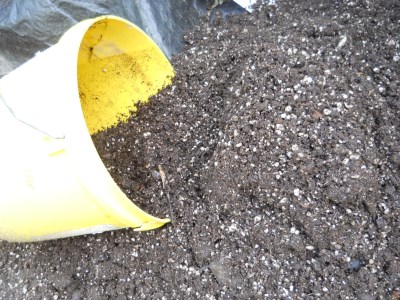In order to ensure excellent oxygen diffusion to the below-ground (in-bag) bark surface of the live cuttings – essential to optimize root initiation and growth here – a highly porous soil growing mix is required.
The soil mix used to produce TRS Cuttings in 2013 and 2014 – and which performed excellently – is presented here first. Please do also read the discussion below.
TRS Cutting Soil Mix
- 4 bails (107 L each) Canadian peatmoss
- 3 bags (110 L each) perlite
- 5 L worm castings
- 2 L Gaia Green 4-4-4 organic fertilizer
- 10 L of forest humus material (mix of mor & moder forms best), highly broken apart by hand.
These ingredients must be very thoroughly mixed together (on a tarp) before wetting. Wetting should make it possible to squeeze water from the mix, but not to the point where water runs out onto the tarp on its own. Note that the forest humus material must be collected in a very ecologically sensitive and dispersed fashion; this makes up < 2% of the mix and is meant solely as a microbial / mycorrhizal inoculant. Note also that this mix is about 43% perlite by volume, making it very highly porous. The use of peatmoss, and especially perlite, does also make it somewhat expensive to produce as well.
View of soil mix described above.
Discussion
Thus far the soil mix used to produce TRS Cuttings has consisted primarily of Canadian peatmoss and perlite. This writer is well aware of negative environmental and global carbon-balance externalities associated with using these ingredients (both must be trucked a long distance). However, for the development of this growing system, materials that were both easy to acquire and highly uniform were seen as necessary.
The eventual goal of Treebear Native Plants is to produce most or all of our the potting mix from local materials. Any information provided by people with expertise in this area (nursery potting mixes) would also be greatly appreciated (see Feedback).
It must be remembered, however, that when such plants are used for ecosystem restoration purposes, there will be significant carbon-sequestration benefits obtained as well over time.

